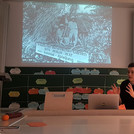Postcolonial Audioguide for Potsdam
by Anna von Rath and Yann Le Gall
30 November 2019
Park Sanssouci, Potsdam (guided tours offered by Postcolonial Potsdam)
In cooperation with: the Research Training Group Minor Cosmopolitanisms
Supported by: Engagement Global
Members of the working group Postcolonial Potsdam invited experts on colonial history and postcolonial cultures to present different aspects of Potsdam’s colonial heritage. This gathering aimed to produce content for an upcoming mobile app that could guide its users through Potsdam and make them aware of traces of colonial history in the city, especially in the famous Park Sanssouci. This project, a cooperation with the Research Training Group Minor Cosmopolitanisms, with additional support from Engagement Global, draws on five years of experience with guided tours offered by Postcolonial Potsdam.
The workshop started with a peculiar anecdote: in 1890, mountain climber Hans Meyer brought a rock from the top of the Kilimanjaro mountain and offered it to the German Kaiser William II as a symbol of German rule in East-Africa. The rock has been exhibited as a trophy, blending in the lavish architecture of Potsdam’s Neues Palais, the Prussian baroque palace at the western end of the Park Sanssouci. Tanzanian activist Mnyaka Sururu Mboro, co-founder of Berlin Postkolonial e.V., linked this story to his childhood in the Kilimanjaro region. At school, Tanzanian teachers would indeed adopt Eurocentric views on history, teaching their pupils that the mountain was “discovered by the German explorer Johannes Rebmann in 1848”. After defending a critical revision of colonial history that includes the perspective of Tanzanians, he reminded that Hans Meyer’s successful expedition to the top of the mountain should be contextualized in the broader context of colonial violence: Carl Peters, imperial commissioner stationed in the Kilimanjaro at the time, was the architect of brutal oppression and subjection of the local Chaga population.
Stephan Theilig then gave some insights into the lives of Africans, Turks and Tartars employed at the Brandenburg-Prussian courts in the 18th century. He revealed how enslaved foreigners were bought off the Gold Coast or from the Netherlands, and forced to work as servants to noble families. This history relates to Dutch-Prussian relations since the 17th century and the involvement of Brandenburg-Prussia in the transatlantic slave trade. Numerous paintings attest of the presence of Africans and Turks at court, as European aristocracy considered them as exotic servants and tokens of their own worldliness and power. Thanks to the archival register of baptisms, the Christian names of those children and young Africans, Turks and Tartars can be retrieved and their stories can partially be told.
Linked to this history, the persistence of racist imagery and blackface in the Netherlands and in the Dutch quarter in Potsdam was later addressed. Lillian Dam Bracia tackled the figure of Black Pete and demonstrated how this tradition resides in the Dutch colonial era and its colonial imaginary. She convincingly argued that this figure should be critically reworked and that the practice of blackface should end.
Elisabeth Nechutnys focussed on Chinese presence in Potsdam, especially the lives of Fung Asseng and Fung Ahok. First employed as living exhibits in exotic shows, they settled at court and greatly contributed to the birth of sinology in Germany. Their travels and different lives offer a compelling example of the close bond between capitalism, colonialism, migration and racial anthropology and physiognomy.
Fabienne Imliger presented the history of the palace Sans-Souci. Not the one standing in Potsdam, but the one built by Haitian General Henry Christophe at the dawn of Haitian independence. Despite the analogy in name, the palaces are nothing alike. Yet, they have been compared in travel writing throughout the centuries, and this relationship offers an interesting opportunity to talk about the history of slave liberation and self-determination in the Caribbean; a way to provincialize the history of castles.
Christoph Wunnicke broadened the scope of points of interest beyond Park Sanssouci to the Potsdam agglomeration. He informed the working group on the entanglements between anti-colonial struggles and the history of the GDR. Besides, the Babelsberg film studios also actively participated in presenting colonial propaganda and exoticizing views on Africa on screen.
Naomie Gramlich and Annika Haas introduced the colonial genealogy of botanical gardens. They showed how the history of science and its practice of collecting and classifying nature is rooted in colonial expansion and the erasure of indigenous knowledge. In Potsdam, original plant specimen from former German colonies are cultivated and their genome is preserved and protected, whereas some of these species are actually endangered in their countries of origin. The workings of colonial capital and globalization have rendered them vulnerable to the invasion of ecosystems by non-indigenous species.
The different presentations touched upon core issues concerning racist language, accessibility and the scope of the Audio-Guide. While the participants agreed on integrating an explanatory glossary and a person index, the question of an appropriate language register remains hanging. The task at hand is to convey complex and entangled histories for a broad public in succinct, intelligible and attention-grabbing podcasts. The members of Postcolonial Potsdam, Anna von Rath, Elisabeth Nechutnys, Kaja Schroeter and Yann Le Gall, have collected the recommendations of workshop participants and critical observer Nouria Asfaha from the organization Each One Teach One. They now need to find an adapted medium to accommodate those various histories, colonial traces that are still largely unknown to Potsdam inhabitants and visiting tourists.






